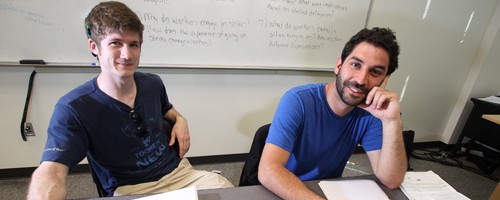Sugar-free Halloween still sweet
“There’s going to be a treasure chest over there,” said Jeanne Duvall to her grandson last May, a year after he was diagnosed with diabetes. “And when you open it, it’s going to tell you what you’re going to do with your life.” He reached into the imaginary chest and ran back to her proclaiming: “I’m going to be a re-healer.”
Duvall interpreted the curious utterance as Ian’s way of saying that health is the natural condition and that he wants to help people return to that state.
Since his diagnosis two years ago, 9-year-old Ian must receive daily injections of insulin, often having to wake at 1 or 2 a.m. to check his blood glucose level, Duvall said. He carefully monitors his diet for carbohydrate intake, and during lunchtime at school he visits the school nurse for testing and shots if needed.
Ian must follow a careful diabetes management plan in order to stay healthy and avoid the severe long-term complications associated with diabetes, including damage to kidneys, eyes, nerves, blood vessels, gums and teeth.
“He always tries to keep covered up his arms and belly where he injects,” Duvall, a child and family studies major at PSU said. “Always has bruised areas.”
The holidays – and especially sweet Halloween treats – pose a special challenge for children with diabetes.
Dr. Mark DeBoer, a Pediatric Endocrinologist at Doernbecher Children’s Hospital, said that sweets eaten in moderation during the holidays are usually not a problem for diabetic children. Diabetic children should already have carbohydrate allotments planned into their diet, he said.
But if children with diabetes choose to eat candy on these special occasions, they might forego other carbohydrates, such as potatoes or whole grain breads that have a better overall nutritional value.
The risk of eating too much candy is that it can lead to rapid spikes in blood sugar level, DeBoer said, and a diet that is consistently high in simple sugars can increase the risk of long term complications associated with diabetes.
In order to provide a healthy alternative for her grandson and other children with diabetes, Duvall set out to create a sugar-free Halloween party last year. She searched throughout Portland for alternative Halloween fun but found only one event, sponsored by Emanuel Hospital, which was planned with the dietary needs of diabetic children in mind.
The problem with the hoedown was the cost, Duvall said. “They charge $5 a head and that just didn’t seem fair because when kids go trick-or-treating they don’t pay. It’s something the community gives them.”
Believing that the community would rally around a no-cost sugar-free Halloween, Duvall began organizing for last year’s party six weeks before Oct. 31. She utilized the popular online resource Craigslist, which helped recruit half-dozen volunteers. She then tapped into PSU’s Portland Pre-Health Society that provided close to 30 additional volunteers.
Last year, on the day of the party there were dozens of volunteers helping in the kitchen, monitoring safety and running various activities including face-painting, pumpkin-decorating, apple-bobbing and “mystery-boxing.” The mystery boxes contained some of the scarier elements, according to Ian. “I pulled out a fake finger,” he said. “I dropped it.”
“That was kind of our fear factor last year,” Duvall said. “This year we’ll add to that – build a little nightmare before Christmas scene village.” The haunted village might have a few spiders hanging low enough to brush children’s faces, “little scary things, but minimal.” A new partner in the sugar-free Halloween party, a student art group, volunteered to create the haunted scene.
The event this year will again be co-sponsored by the Portland Pre-Health Society. The group of future health care professionals is helping with volunteer recruitment, acquisition of donations and anything else that Duvall may need assistance with, said Colleen Amann, advertising officer for the Portland Pre-Health Society and a senior biology major.
Entertainment will include a jack-o’-lantern contest, string apple-bobbing, balloon artistry by Balloon Man Joe and many additional surprises.
Local grocers have stepped up and offered food for the party, Duvall said. The Alberta Cooperative Grocery has donated fruits and vegetables, and New Seasons Market has donated a dollar amount for food. Pizza will likely be on the menu and possibly some freshly made guacamole. A local chef will help with food preparation and supervision of volunteers in the kitchen.
If it were up to Jeanne’s grandson, Ian, the menu for the party would include a couple of his holiday concoctions. “Maybe they could serve spaghetti with grapes in it,” he said. And in the spirit of Halloween, he would like to see “Apple sauce – mix it with red stuff so it’s like mushy blood.”
The disease is taxing on Ian’s energy level, Duvall said, adding that the daily management of his health affects his ability to make new friends. “He is not wanting to explain himself,” she said. “We all want to be unique. We don’t want to be different.”
With Type I diabetes, which Ian has, the immune system attacks the beta cells of the pancreas which produce insulin and regulate blood sugar. Insulin is a hormone that enables the body to utilize sugar for energy, and without sufficient amounts, the “body loses its main source of fuel,” according to the National Diabetes Education Program.
If Ian decides to pursue a health care career focusing on helping children with diabetes, he will have plenty of work to do. One out of every 400 or 500 children in the United States has diabetes, according to the American Diabetes Association. Approximately 210,000 people under the age of 20 are diabetic.
In April 2004, Ian was rushed to the Emanuel Hospital emergency room immediately after his naturopathic doctor found troubling signs indicative of diabetes.
Less than two years since his four-day hospitalization, Ian is concerned about the health of his baby sister, Emma, who was born a month ago. “It was so sweet,” Duvall said. “The first day I went over and saw her, he goes, ‘Grandma, I really hope she doesn’t get diabetes.'”
The Sugar-Free Halloween Party will be held on Sunday, Oct. 30, from 3 to 6 p.m., at the Native American Student and Community Center, located at the corner of 710 S.W. Jackson Ave. If you would like to volunteer or make a donation to the event, contact [email protected].





